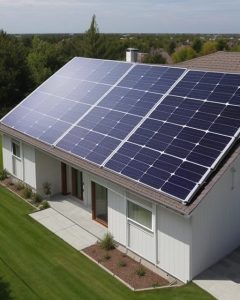As the world embraces sustainable energy solutions, homeowners are increasingly turning to solar power to offset costs and reduce their carbon footprint. This paper explores the benefits of solar energy for homeowners, discussing the installation process, financial considerations, and strategies to maximize cost offset while contributing to a greener future.
Solar power offers homeowners a renewable energy source that can significantly reduce electricity bills and lessen dependence on fossil fuels. With advancements in technology and government incentives, installing solar panels has become more accessible and financially viable for homeowners. This paper aims to provide a comprehensive guide for homeowners looking to harness solar power to offset costs and promote sustainability.
One of the primary benefits of solar power is its potential for significant cost savings on electricity bills. By generating electricity from sunlight, homeowners can reduce or eliminate their reliance on grid electricity, thus lowering their monthly utility expenses. Solar power is a clean, renewable energy source that produces minimal greenhouse gas emissions compared to traditional fossil fuels. By utilizing solar energy, homeowners can reduce their carbon footprint and contribute to mitigating climate change. Solar power provides homeowners with greater energy independence by generating electricity on-site. This reduces vulnerability to fluctuations in utility prices and disruptions in the power grid, enhancing resilience during emergencies. Homes equipped with solar panels typically command higher property values and sell faster than those without. Solar installations are viewed as valuable assets that offer long-term cost savings and environmental benefits, making properties more attractive to potential buyers.
A professional solar installer conducts a site assessment to evaluate the suitability of the property for solar panel installation. Factors such as roof orientation, shading, and structural integrity are assessed to determine the optimal placement of solar panels. Once the site assessment is complete, the solar installer designs a customized solar energy system tailored to the homeowner’s energy needs and site conditions. The design is submitted for permitting approval from the local authorities before installation can proceed. The solar panels, inverters, and mounting hardware are installed on the homeowner’s property according to the approved design. This typically involves securing the panels to the roof or ground-mounted racks and connecting them to the electrical system. After installation, the solar system is interconnected with the utility grid through a net metering agreement. This allows excess electricity generated by the solar panels to be fed back into the grid for credits, which can be used to offset future electricity bills.
The upfront costs of installing a solar energy system vary depending on factors such as system size, equipment quality, and installation complexity. However, homeowners can recoup their investment through long-term energy savings and potential incentives. Government incentives, such as the federal investment tax credit (ITC) and state-specific rebates, can significantly reduce the cost of installing solar panels. Homeowners should research available incentives and consult with a tax professional to maximize savings.
Financing Options: Many solar installers offer financing options, such as solar loans and leases, to help homeowners finance their solar installations with little to no upfront costs. These financing options allow homeowners to pay for their solar systems over time while still enjoying immediate cost savings on electricity bills.
Return on Investment (ROI): Calculating the ROI of a solar energy system involves considering factors such as upfront costs, energy savings, incentives, and system longevity. Despite the initial investment, solar power offers homeowners a favorable ROI over the lifespan of the system, typically ranging from 5 to 20 years depending on various factors.
Properly sizing the solar energy system to match the homeowner’s energy needs is crucial for maximizing cost offset. An oversized system may generate excess electricity that goes unused, while an undersized system may not fully meet the homeowner’s energy demands. Implementing energy efficiency measures, such as installing LED lighting, upgrading appliances, and improving insulation, can complement solar power and further reduce electricity consumption. By minimizing energy waste, homeowners can maximize the cost offset provided by their solar installations. Some utility companies offer TOU billing plans that incentivize homeowners to shift energy consumption to off-peak hours when electricity rates are lower. By aligning energy usage with solar generation patterns, homeowners can optimize cost savings and maximize the value of their solar energy systems. Adding battery storage to a solar energy system allows homeowners to store excess electricity generated during the day for use during periods of low solar production or grid outages. Battery storage systems enhance energy independence and resilience while further reducing reliance on grid electricity.
Harnessing solar power offers homeowners a sustainable and cost-effective solution to offset electricity costs while reducing their environmental impact. By understanding the benefits of solar energy, navigating the installation process, considering financial implications, and implementing strategies to maximize cost offset, homeowners can enjoy the long-term rewards of clean, renewable energy generation. Embracing solar power not only makes economic sense but also contributes to a greener, more sustainable future for generations to come.

